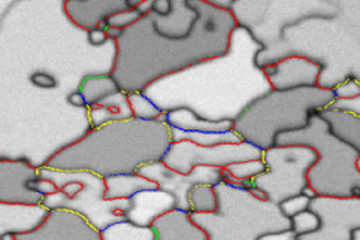All genres
21.
Journal Article
Atom probe tomography. Nature reviews: Methods primers 1, 51 (2021)
22.
Journal Article
Effect of Cd diffusion on the electrical properties of the Cu(In,Ga)Se2 thin-film solar cell. Solar Energy Materials and Solar Cells 224, 110989 (2021)
23.
Journal Article
Dielectric Properties of Nanoconfined Water: A Canonical Thermopotentiostat Approach. Physical Review Letters 126 (13), 136803 (2021)
24.
Journal Article
First-principles investigation of charged dopants and dopant-vacancy defect complexes in monolayer MoS2. Physical Review Materials 4 (11), 114002 (2020)
25.
Journal Article
Atomic relaxation around defects in magnetically disordered materials computed by atomic spin constraints within an efficient Lagrange formalism. Physical Review B 102 (14), 144101 (2020)
26.
Journal Article
Generalized dipole correction for charged surfaces in the repeated-slab approach. Physical Review B 102 (4), 045403 (2020)
27.
Journal Article
Stability of charged sulfur vacancies in 2D and bulk MoS2 from plane-wave density functional theory with electrostatic corrections. Physical Review Materials 4 (6), 064004 (2020)
28.
Journal Article
Ab initio Description of Bond-Breaking in Large Electric Fields. Physical Review Letters 124 (17), 176801 (2020)
29.
Journal Article
Finite-size corrections for defect-involving vertical transitions in supercell calculations. Physical Review B 101, 020102(R) (2020)
30.
Journal Article
Imaging individual solute atoms at crystalline imperfections in metals. New Journal of Physics 21 (12), 123020 (2019)
31.
Journal Article
Ab initio vibrational free energies including anharmonicity for multicomponent alloys. npj Computational Materials 5 (1), 80 (2019)
32.
Journal Article
Predicting the Electrochemical Synthesis of 2D Materials from First Principles. The Journal of Physical Chemistry C 123 (5), pp. 3180 - 3187 (2019)
33.
Journal Article
Discovery of Elusive K4O6, a Compound Stabilized by Configurational Entropy of Polarons. Angewandte Chemie International Edition 58 (1), pp. 149 - 153 (2019)
34.
Journal Article
Advances in Density-Functional Calculations for Materials Modeling. Annual Review of Materials Research 49, pp. 1 - 30 (2019)
35.
Journal Article
First-principles calculations for charged defects at surfaces, interfaces, and two-dimensional materials in the presence of electric fields. Physical Review B 97 (20), 205425 (2018)
36.
Journal Article
Elastically frustrated rehybridization: Origin of chemical order and compositional limits in InGaN quantum wells. Physical Review Materials 2 (1), 011601 (2018)
37.
Journal Article
First-Principles study of intrinsic defects in ammonia borane. The Journal of Physical Chemistry C 121 (41), pp. 22680 - 22689 (2017)
38.
Journal Article
Electronic structure of metastable bcc Cu–Cr alloy thin films: Comparison of electron energy-loss spectroscopy and first-principles calculations. Ultramicroscopy 178, pp. 96 - 104 (2017)
39.
Journal Article
Accurate electronic free energies of the 3d, 4d, and 5d transition metals at high temperatures. Physical Review B 95 (16), 165126 (2017)
40.
Journal Article
On-the-fly parameterization of internal coordinate force constants for quasi-Newton geometry optimization in atomistic calculations. Computational Materials Science 133, pp. 71 - 81 (2017)











